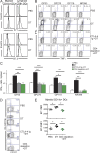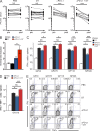Interplay between regulatory T cells and PD-1 in modulating T cell exhaustion and viral control during chronic LCMV infection
- PMID: 25113973
- PMCID: PMC4144726
- DOI: 10.1084/jem.20132577
Interplay between regulatory T cells and PD-1 in modulating T cell exhaustion and viral control during chronic LCMV infection
Abstract
Regulatory T (T reg) cells are critical for preventing autoimmunity mediated by self-reactive T cells, but their role in modulating immune responses during chronic viral infection is not well defined. To address this question and to investigate a role for T reg cells in exhaustion of virus-specific CD8 T cells, we depleted T reg cells in mice chronically infected with lymphocytic choriomeningitis virus (LCMV). T reg cell ablation resulted in 10-100-fold expansion of functional LCMV-specific CD8 T cells. Rescue of exhausted CD8 T cells was dependent on cognate antigen, B7 costimulation, and conventional CD4 T cells. Despite the striking recovery of LCMV-specific CD8 T cell responses, T reg cell depletion failed to diminish viral load. Interestingly, T reg cell ablation triggered up-regulation of the molecule programmed cell death ligand-1 (PD-L1), which upon binding PD-1 on T cells delivers inhibitory signals. Increased PD-L1 expression was observed especially on LCMV-infected cells, and combining T reg cell depletion with PD-L1 blockade resulted in a significant reduction in viral titers, which was more pronounced than that upon PD-L1 blockade alone. These results suggest that T reg cells effectively maintain CD8 T cell exhaustion, but blockade of the PD-1 inhibitory pathway is critical for elimination of infected cells.
© 2014 Penaloza-MacMaster et al.
Figures









References
-
- Ahmed, R., Salmi A., Butler L.D., Chiller J.M., and Oldstone M.B.. 1984. Selection of genetic variants of lymphocytic choriomeningitis virus in spleens of persistently infected mice. Role in suppression of cytotoxic T lymphocyte response and viral persistence. J. Exp. Med. 160:521–540 10.1084/jem.160.2.521 - DOI - PMC - PubMed
-
- Aubert, R.D., Kamphorst A.O., Sarkar S., Vezys V., Ha S.J., Barber D.L., Ye L., Sharpe A.H., Freeman G.J., and Ahmed R.. 2011. Antigen-specific CD4 T-cell help rescues exhausted CD8 T cells during chronic viral infection. Proc. Natl. Acad. Sci. USA. 108:21182–21187 10.1073/pnas.1118450109 - DOI - PMC - PubMed
Publication types
MeSH terms
Substances
Grants and funding
LinkOut - more resources
Full Text Sources
Other Literature Sources
Molecular Biology Databases
Research Materials

